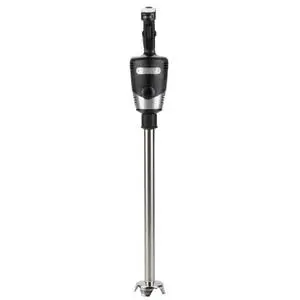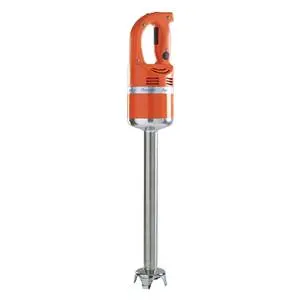Immersion blenders (also known as “boat motors” or stick blenders) and hand mixers are an incredibly useful tool in the realm of the commercial kitchen. Equipment like food processors, commercial blenders, or planetary mixers are useful, however each of them has their own vessel for mixing. This can be a detriment in a kitchen, as some items that need to be mixed will not necessarily be accommodated by the size, location, or type of mixing vessel a stationary piece will have.
Enter hand mixers and immersion blenders. These devices are meant to mix, blend, and whip in any area they are needed. Regardless of the name attached to the device, these mixers are in essence the same; they share the same motor, but often the distinction is made by the attachment being used (though it is relatively arbitrary). A hand mixer used in a commercial setting requires a larger motor, and though these larger motors are a departure from the traditional residential hand mixer shape, they work in much the same way. Let’s take a look at the main things to take into account when purchasing a commercial hand mixer.
Attachments: First and foremost we must return to the distinction that is often made between hand mixers and immersion blenders. More often than not a hand mixer is a mixer with a dual whisk attachment (like the residential ones made to make cake batters), and an immersion blender features stick blender attachment. Most commercial hand mixer motors will be able to accommodate both of these attachments, as well as several others (such as a paddle attachment). Not all hand mixers have removable attachments, so it is important to be aware of what model is being purchased. Additionally, know the other uses of attachments. The stick blender attachment not only mixes and emulsifies, but it can chop in the liquids it is mixing. The attachment features several blades at the bottom (very similar to that of a traditional countertop blender) which can break up solids in whatever is being mixed (making it perfect for smoothing out sauces or soups). It should be noted that there must be liquid present regardless of the attachment being used, as the motor could potentially be damaged from a lack of resistance when running dry.
Motor Power / Shaft Size: The power of the motor is directly related to the size of attachments and the overall capacity of the machine. Manufacturers assign attachments according the power of the motor, not only to ensure they are a perfect fit, but also to keep customers honest. By standardizing shaft and attachment sizes for each model / series of mixer produced, customers are limited as to what they can fully blend. For example, a stick blender that has a capacity of mixing 12 qt. will generally have a mixing shaft that is around 10” long (almost never over that). This prevents them from being used in 5 gallon buckets, which would over work the machine and no doubt shorten the motor life. This tends to be the case with all sizes of immersion blenders, though many companies do not list the mixing capacity of their mixers. For information on the mixing capacity of a commercial hand mixer, contact the manufacturer.
Electrical Operation: Most all commercial hand mixers operate on 120v / 60 hz. / single phase electric. Operations looking for models that run on a different voltage should speak with a sales associate or with the manufacturer as some models can be altered to work on a different electrical configuration.



